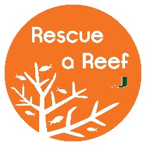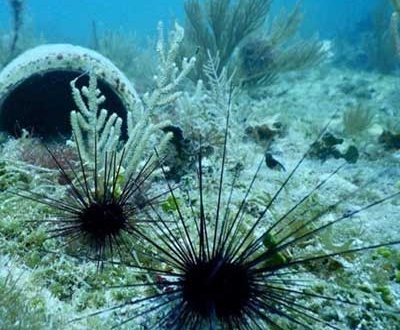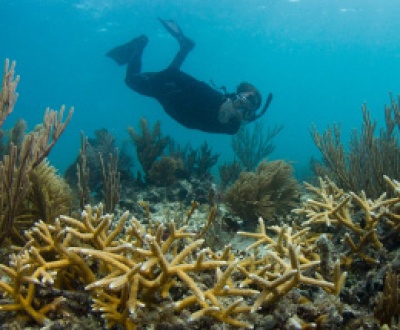Underwater Gardening Anyone?
- October 19, 2020
- Diego Lirman

Dr. Diego Lirman surveying a restored coral reef plot. All of the branching corals shown were grown in the UM nursery and planted onto a depleted reef.
Our precious coral reefs, here in Florida and around the world, are in trouble. That should not be news to anyone that cares about our wonderful planet and the incredible and diverse natural ecosystems we rely on for a wide range of key services. Healthy reefs provide us with an essential source of protein (I am particularly fond of Florida spiny lobsters!), habitat for commercial and recreational fisheries, building materials (where do you think all that sand we keep replenishing along our shoreline comes from?), recreation and tourism revenue, education, and, especially important for South Florida, coastline protection. Healthy coral reefs are the first line of defense against the impacts of climatic extremes like hurricanes. A healthy reef can buffer > 90% of the energy of incoming waves. That means reduced physical impacts, less coastal flooding, and lower sand losses. Here in SE Florida, we have the most valuable and vulnerable built coastline in the US. We need healthy reefs to protect us!

PVC tree used to grow 100 corals for restoration at the UM underwater nursery near Key Biscayne, Florida
While the patterns of decline in coral abundance over the last few decades are consistent around the world (Florida reefs now have less than 5% of the reef bottom occupied by stony corals), the causes for reef degradation are diverse and their relative influences vary based on location. In Florida, our reefs have experienced mortality due to the record 2010 cold-water event (remember when we had “popsicle” iguanas falling from the trees?), hurricanes (Andrew in 1992, several in 2015, Irma in 2017), warm-water events in 2014-2015, and the devastating Stony Coral Tissue Loss Disease (SCTLD) that started near Miami in 2014 and has propagated through the entire Florida Reef Tract and beyond. Our reefs are also influenced by the chronic impacts of over-fishing, ship groundings, trash (fishing line and fishing traps are especially damaging to corals), and excess nutrients and contaminants. On top of all of these we have, off course, the impacts of climate change in the form of increased water temperatures, ocean acidification, and sea-level rise. In fact, if you think about it, it is actually a miracle we still have some corals and coral reefs left to protect and recover.

UM student planting a nursery-grown staghorn coral.
But we do have corals and reefs left to protect and recover. And this is exactly what my lab at the University of Miami has been doing for over two decades. I came to Miami in 1992 two weeks before Hurricane Andrew (great timing right?). Hurricane Andrew caused widespread destruction to both terrestrial and marine systems but also gave me a dissertation project. I documented the impacts of Andrew (and a few additional ones that came after 1992) on coral reefs and fell in love with Florida reefs. I spent the following almost 30 years studying the disturbance ecology of coral reefs (a fancy way of saying I observed a lot of corals die) and learning what factors drive the response of corals to stress.
Then, in 2007, came around one of those once-in-a-lifetime opportunities. A group of coral researchers and managers came together to build the “Florida Reef Restoration Program”. After watching corals die for so long, it was time for me to start doing something to help these precious resources recover. This group of passionate and motivated reef restoration pioneers included researchers and practitioners from the University of Miami, NOVA Southeastern University, Mote Marine Lab, Coral Restoration Foundation, the Nature Conservancy, and the Fish and Wildlife Conservation Commission.

Small coral colony planted onto a Miami reef.
The framework we used to build this unprecedented regional collaboration was the “Coral Gardening” methodology (Yes, you can actually garden underwater!). This process was first developed in the Red Sea in the 1990s and is now widely applied around the world to propagate corals and repopulate depleted reefs. The concept is very simple and deeply grounded in terrestrial silviculture principles. Small pieces of wild coral colonies are collected and placed within in-water coral nurseries where these corals are grown, pruned, and propagated until we reach large numbers of coral fragments for restoration. Corals are much like plants that can grow new colonies from fragments. In fact, we have shown that corals undergo “pruning vigor” where they increase their growth after being pruned or fragmented. After propagation within underwater nurseries (we now have 1000s of corals of 100s of parent coral colonies in our nurseries in Miami-Dade County alone), we plant these nursery-grown corals onto our depleted Florida reefs. Now, after a short 12 years of doing this work, we are planting 10,000s of corals onto Florida reefs on a yearly basis with amazing success!
If you are interested in learning more about our process, how our restored reefs are doing, and how to get involved in reef restoration locally, please read my next blog.
Diego Lirman, Ph.D.
University of Miami
Email: dlirman@rsmas.miami.edu

Rescue A Reef Program: rescueareef.rsmas.miami.edu
Facebook: https://www.
Twitter: https://twitter.com/
Instagram: https://www.
About the Author

Sign up here for email notifications about new Hothouse Blog articles!
More articles on the subject
See all postsRecent Posts
- April 2023 April 1, 2024
- Good News on Environmental Plastics February 1, 2024
- Material World / Plant World January 1, 2024
Leave a Comment cancel
This site uses Akismet to reduce spam. Learn how your comment data is processed.










Dear Dr. Lirman,
I am fascinated by the work you do and can’t wait to read your next post. I’m very interested in how I can participate in the volunteer program.
Susan
Glad you enjoyed the blog. Please check out our lab website at http://www.rescueareef.com
for additional information on our activities
regards and stay healthy